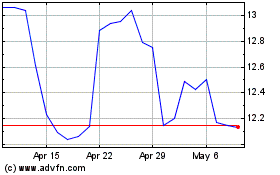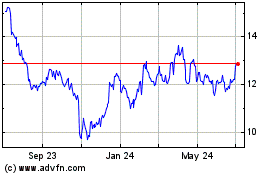By Christina Rogers and Mike Colias
Ford Motor Co. is reigniting a turf war in a lucrative segment
dominated by General Motors Co., giving the supersize Expedition
and Lincoln Navigator lineup its first overhaul in nearly 15
years.
Ford was once a force in the market for hulking SUVs, but slowed
investing in the gas guzzlers as the car maker responded to
environmental concerns by shifting to more efficient models. GM,
meanwhile, cranked out consistent redesigns of the Chevrolet Tahoe,
Cadillac Escalade and other models, and now outsells Ford by a
4-to-1 margin in the category.
That dominance feeds $2 billion to GM's bottom line annually,
according to analyst estimates. Ford, looking for ways to bolster
profit, is hoping to benefit from the retooled SUVs.
"We think we're going to be able to shake up that market," Joe
Hinrichs, Ford's North America president, said in a recent
interview. Sale chief Mark LaNeve said the company aims to "gain
considerable share...this is a tremendously profitable
vehicle."
The new Expedition model was officially unveiled on Tuesday in
Dallas.
The Dearborn, Mich., auto maker's move comes as American vehicle
buyers, influenced by cheap gas prices, overwhelmingly prefer
pickups and SUVs to sedans. At Ford, its compact Focus, Fusion
sedan and sporty Mustang have been met with tepid demand.
Auto executives have worried that overreliance on SUVs would
hinder their meeting emissions targets in place through 2025, but
the Trump administration has said it may ease those rules.
At meetings at the White House last month, Ford CEO Mark Fields
said he pressed for a review of the regulations, arguing the
targets don't align with the high demand right now for larger
models amid continued low fuel prices.
The redesigned Expedition, which along with a new Navigator will
arrive in dealerships this fall, represents the first in a line of
new products Ford is planning for the SUV segment through 2020. The
company also will revive its rugged Bronco SUV and add its EcoSport
small SUV sold in emerging markets and Europe.
Others in the industry are looking to counter weak demand for
passenger cars. Fiat Chrysler Automobiles NV, for instance, has
laid out aggressive plans to add bulkier SUVs to its Jeep lineup,
also in an attempt to catch GM.
GM's lead in the large SUV segment stems from decisions made
before the company's 2009 bankruptcy. As former Ford chief Alan
Mulally backed away from investments in the segment, GM deemed the
profit margins as too attractive to give up and approved plans to
improve six SUV models even as finances were strained.
"It turned out to be a hell of a lot more than anyone else was
doing," Bob Lutz, who led GM product development at the time of
that decision, said in an interview. He noted the company planned
to invest even more, but had to pull back because of its shrinking
cash position.
In its SUV initiative, Ford is taking a page from its playbook
for its highly successful pickups by using aluminum for body
panels. In switching from a steel body, the new Expedition takes on
added cost but also is expected to achieve better fuel economy by
dropping 300 pounds in weight. The model also has new technologies,
such as a wireless charging pad for smart phones and built-in WiFi
connectivity.
Unlike in the market for full-size trucks, which F-Series models
have dominated since 1977, Ford is an also-ran in the race for
buyers of large SUVs built by mainstream brands. In 2016, the
Expedition held just 17% of that market, compared with GM's 74%,
according to JD Power. Nissan Motor Co. and Toyota Motor Corp. also
compete in the segment.
The Chevrolet Tahoe, Suburban and GMC-branded counterparts sell
for nearly $59,000, 12% higher than Ford's $52,500 Expedition, JD
Power estimates. While GM has long held a wide market-share lead,
the price gap was far narrower in the years after the Expedition's
2003 redesign.
The differential is even more pronounced on the luxury end of
the business, where auto makers earn a disproportionate amount of
profit. GM's Escalade sells for $78,769 on average, nearly $20,000
more than what Ford can get for a Lincoln Navigator.
"Assuming merely a 20% margin on these products (could be more),
the gap at the pretax level could be well in excess of $2 billion,"
Morgan Stanley auto analyst Adam Jonas said in a recent note to
investors. Ford earned $9 billion in North American operations last
year, while GM's earnings for the region reached $12 billion.
A GM spokesman said the company's continued investment in the
lineup has achieved "the highest owner loyalty in the large SUV
segment." The company also has succeeded by luring drivers of
smaller premium wagons made by rivals. The company's large SUVs are
now seen as an alternative to minivans due to better fuel
economy.
Shannon Meyers, an elementary school principal, recently traded
in her Acura MDX crossover--based on Honda Motor Co.'s Accord sedan
architecture--for a $72,000 Tahoe. The meatier Tahoe, sharing its
underbody with a pickup, gets better gas mileage than the
six-year-old Acura, she said.
"It didn't take long to get used to the bigger size," said Ms.
Myers, who has two school-age children.
Ford dealers are itching to have a broader lineup to offer.
"It's sorely needed," said Jeff Smith, general manager at
Helfman Ford in Houston. "I have folks right now who are ready to
buy, and they're waiting for the new one to arrive."
Write to Christina Rogers at christina.rogers@wsj.com and Mike
Colias at Mike.Colias@wsj.com
(END) Dow Jones Newswires
February 07, 2017 12:14 ET (17:14 GMT)
Copyright (c) 2017 Dow Jones & Company, Inc.
Ford Motor (NYSE:F)
Historical Stock Chart
From Mar 2024 to Apr 2024

Ford Motor (NYSE:F)
Historical Stock Chart
From Apr 2023 to Apr 2024
